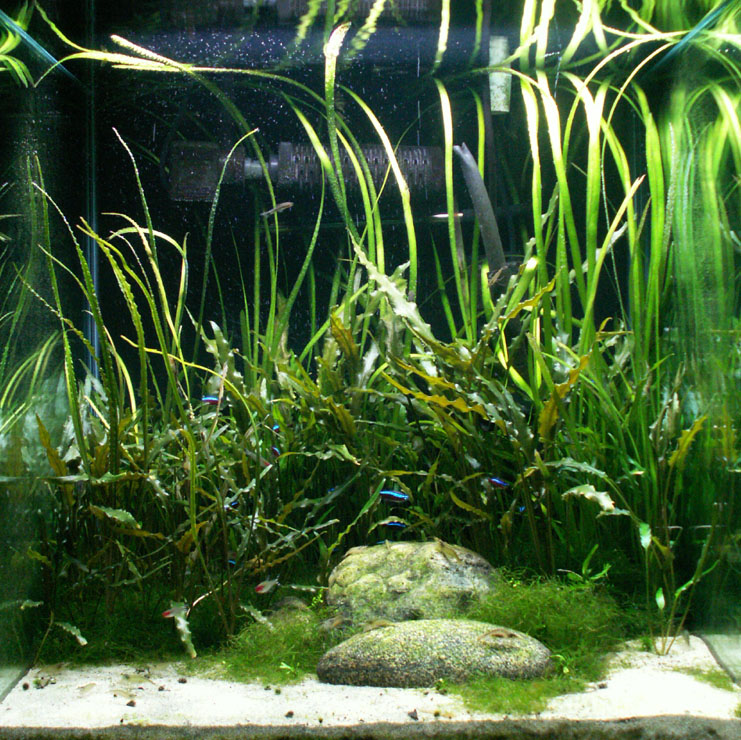A couple of years ago (2007), I was walking through a local flea market and ran across a vendor that sold wood furniture imported from Indonesia. I spotted a solid wood end stand/cabinet that measures 28" long X 28" wide X 24" high (71 cm long X 71 cm wide X 60 cm high). I checked the construction and determined it would make a great aquarium stand. I bought it for $90 and thought about how much cheaper and better quality it was than aquarium stands sold in pet and aquarium stores. I had Catalina Aquarium build a custom 60-gallon (228 L) (24" X 24" X 24" or 60 cm X 60 cm X 60 cm) glass aquarium and lighting system.

Before installing the aquarium, I spray-painted the back black and drilled a hole in the back of the cabinet for the electrical plugs and tubing.
Since the aquarium would be a planted tank, I had to consider what type of lighting I would use. Since the aquarium is only 24 inches (60 cm) wide, I had only two good options, compact fluorescent and metal halide. Standard fluorescent bulbs in 18" (45 cm) or 24" (60 cm) lengths just do not have the intensity to penetrate 24 inches (60 cm) of water needed to make the plants grow well. LED's (Light Emitting Diodes) were new to the market, expensive, and unproven aquarium lighting technology. I did not choose the metal halide option because of the excessive heat they generate. I chose to go with a hood that has three 65-watt compact fluorescent bulbs. This allowed me to put 195 watts of light over a 24" (60cm) by 24" (60cm) surface area.
Catalina Aquarium had recently come out with a new lighting system option that was marketed to reef hobbyists; that used a programmable remote control that allowed the aquarist to turn on/off at set times three different circuits of lights. Typically they would turn on/off blue LEDs, metal halides, and compact fluorescents at other times. I worked with Catalina Aquarium to modify the hood for a planted aquarium using carbon dioxide (CO2) injection. Instead of having three separate circuits to control each bulb, the hood was configured to use one circuit to control two 6500K bulbs, one circuit to control one pink plant bulb, and one circuit to control a power cord that would go from the hood to the cabinet where the electronic solenoid that controlled the flow of CO2 to the aquarium would plug in. The power cord from the hood allows the program to control when the CO2 is turned off and on.
The lighting system on/off sequence is programmed on the remote control first; then, it is sent to the hood by pointing it at the sensor installed in the hood and pressing the send button on the remote. I have the hood programmed so the CO2 comes on one hour after the lights come on and go off one hour before the lights go out. This programming sequence is because when the lights are out, plants stop taking up CO2, start taking up oxygen, and start producing CO2. Excessive CO2 can drive the pH down to an undesirable level.
The filtration system for the aquarium uses two Catalina Aquarium CA1400 power heads that I attached Hagen Quick Filters to the intakes. One powerhead pushes water through a Coralife Turbo-Twist 3x 9-watt ultraviolet sterilizer that sits on top of the glass top. The other power head has a venturi stem connected to the tubing from the CO2 bottle.
The venturi on the power head allows CO2 to be turned into microbubbles. I attached 5/8" (16 mm) black plastic irrigation tubing, a "T" and an elbow (purchased at the local hardware store) to the output of the CA1400 power head with CO2 injection. The "T" is attached to the power head so that the effluent from one end faces up towards the surface. A 6" (15 cm) plastic tube that had one end heated up and compressed was attached to the end of the "T" that is pointed at the surface. One end pointed at the surface allows the surface to be agitated for gas exchange. The other end of the "T" has an elbow attached to move CO2-saturated water to be moved around near the bottom of the aquarium.
The heater is a Catalina Aquarium 300-watt titanium. This heater has the thermostat integrated into the plug, allowing easy temperature adjustment without lifting a cover off and getting your hands wet.
Substrate is #60 (mesh or grit [very fine]) natural sand I bought at a local rock and landscaping supply yard. I use sand in all my aquariums. Sand helps keep the detritus on top of the substrate so it can be filtered out. I inject SeaChems Flourish into the sand bed with a plastic syringe every few months.
Plants include Italian val (Vallisneria spiralis), Cryptocoryne walkeri, Cryptocoryne spiralis, and Java moss (Vesicularia dubyana).
The fish are cardinal tetra (Paracheirodon axelrodi), rummy-nose tetra (Hemigrammus rhodostomus), otocinclus cats (Otocinclus vestitus).
Invertebrates include algae eating shrimp (Caridina japonica), and Malaysian livebearing snails (Melanoides tuberculata).
Maintenance includes 95% water changes every two to four weeks, wiping down the inside glass once a month, and pulling out excess plants. Because the system is very balanced, little algae growth must be cleaned off the glass. pH of the aquarium ranges between 6.4 and 7.2. I add a teaspoon of sodium bicarbonate to the tank to keep the pH up. The temperature of the aquarium ranges between 80° and 82° F (26° and 28° C).
